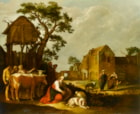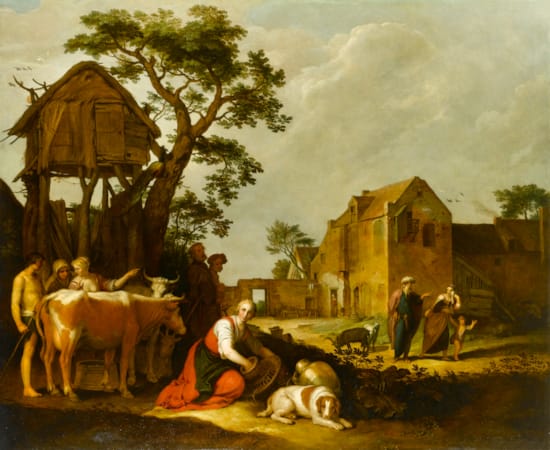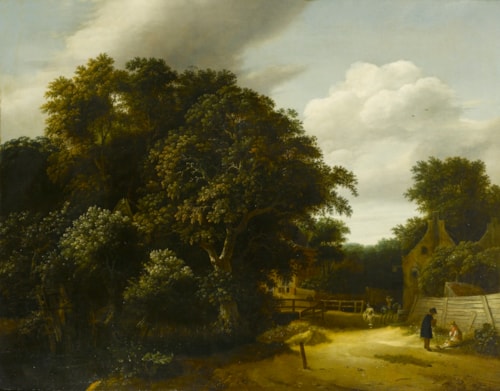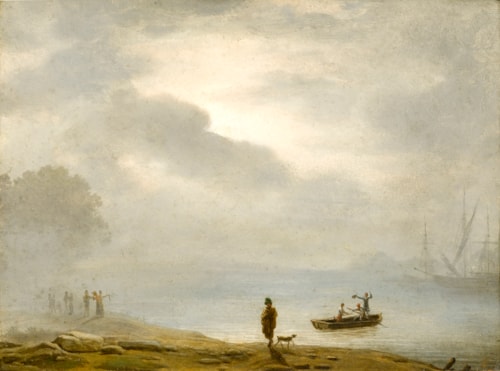braham Bloemaert
(Gorinchem 1566 - Utrecht 1651)
The Expulsion of Hagar and Ishmael
signed ‘A Blomert fe. ./16..8’ (lower left)
oil on canvas
150 x 184 cm (59 x 72½ in)
The Expulsion of Hagar and Ishmael, formerly in the collection of the J. Paul Getty Museum, is a notable example of the work of the Dutch master Abraham Bloemaert. Bloemaert was one of Utrecht’s principal painters during the first half of the seventeenth century, and was known, in his mature works, for synthesising Mannerist and Caravaggesque elements in a distinctive and decorative manner.
The narrative in the present work is based on Genesis, chapter 21. Hagar was the handmaiden of Abraham’s wife Sarah. As Sarah was infertile, she offered Hagar to her husband as a second wife, so that he might have a son, and Abraham’s firstborn Ishmael was duly born. However, some years later Sarah did manage to miraculously conceive, but when she discovered Ishmael mocking the infant Isaac, she demanded that mother and child be expelled from the household. Abraham was reluctant, but complied on God’s advice. It is this scene which Bloemaert depicts on the right-hand side of the work, as Abraham sends a weeping Hagar and distressed Ishmael out into the wilderness. Behind them, peering out from the doorway of the farmhouse, Sarah surreptitiously watches on.
The biblical aspect in The Expulsion of Hagar and Ishmael is by no means the central focus of the painting, and this is typical of Bloemaert’s mature work. The viewer’s first impression is that this is a genre scene of a contemporary farmyard. A group of farmhands, surrounded by cattle, have stopped in their work to observe the expulsion, and some quietly gossip. One worker, however, continues to work on a basket, ‘a model of domestic virtue, shown as diligent and obedient’.⁴ It has been suggested that given the prominence of this figure ‘the image of Hagar’s banishment functions as a punishment incurred for the disregard of authority; the dog probably alludes to fidelity’.⁵ Throughout the work delightful details abound, such as the dovecote, the peacock, or the grazing goats, unaware of the domestic turmoil taking place nearby.
Despite the distinctly humble air, Bloemaert’s composition is rooted in the classical tradition. The left-hand side is dominated by the tall vertical motifs of the figures, the tree, and the dovecote. In contrast the right-hand side is far more open with an increase of sky and space, and this half of the picture is framed by slightly dilapidated stone walls, as opposed to the wood of the left-hand side. However, these two very distinct halves are linked beautifully by Bloemaert, through gesture and glance, to create a lively and unified work.
The date of The Expulsion of Hagar and Ishmael reads ‘16*8’. On stylistic grounds the missing number must either be ‘2’ or ‘3’, and Marcel Roethlisberger, the acknowledged expert on Bloemaert, believes that the present work was executed in 1638.⁶ He compares it to another painting of the same subject, which is dated 1635. In both works Bloemaert has treated the narrative in a comparable manner, in that it is relegated to the middle ground, and the work is dominated by a charming scene of rural life. Specific motifs also recur, such as the young peasant woman, the spaniel, the milk jar, the dovecote and the peacock.
When comparing the two works, Roethlisberger says that although the broad interpretation of the subject is unchanged, what has developed in the three intervening years is ‘a clarification of the composition’, evident in the present painting.⁷ Bloemaert used a more deliberate and formal composition, with two very distinct halves and a greater understanding of space, which results in ‘an intensification of the thematic message’.⁸ The Expulsion of Hagar and Ishmael has a more classical composition than the earlier version and ‘The result of this classicism of the aged Bloemaert is a meditative composition, alive yet immutable, far from the picturesque farmyard clutter depicted by such contemporary masters as Teniers’.⁹
Another work comparable to The Expulsion of Hagar and Ishmael is The Prodigal Son as Swineherd, (1637, Kenwood House, London) which is dated a year before the present work. The setting is again a contemporary farmyard, and Bloemaert has placed two workers in the foreground on the left-hand side, in a manner reminiscent of the present work. This serves to immediately engage the viewer, who is then directed by their glances and gestures to the narrative vignette which takes place in the middle ground. The courtyard is even less cluttered than in The Expulsion of Hagar and Ishmael, and taken together the works are a fine demonstration of Blomaert’s considered mature style.
The Expulsion of Hagar and Ishmael can be seen as a culmination of the narrative landscapes that Bloemaert had been working on throughout the 1620s and 1630s. The Parable of the Wheat and the Tares dates from 1624, and there are clear parallels with the present work. The setting is again a landscape framed by slightly dilapidated farm buildings and the instantly recognisable motif of the dovecote, standing unsteadily on its tall, bowed legs. In the Baltimore work figures and farmyard objects are crowded and almost cluttered into the centre of the foreground, and when compared to the late The Expulsion of Hagar and Ishmael, Bloemaert’s increased spatial awareness and compositional sophistication is remarkably evident.
Bloemaert was born in Gorinchem and moved with his family to Utrecht as a boy, where he began to draw and was tutored by his father Cornelis Bloemaert I (c.1540-1593). He was apprenticed for a short time to the painter Gerrit Splinter (fl.1569-89) and then Joos de Beer (d.1599). Around 1582, he travelled to Paris, where he studied under Jehan Bassot and finally with Hieronymous Francken. This fragmented training with multiple masters was something that Bloemaert complained about in his later years. In 1585, Bloemaert returned to Utrecht, where he probably worked with his father, and six years later accompanied him to Amsterdam for one year, after which he spent the remainder of his life in Utrecht.
In the first decade of the seventeenth century, Bloemaert began formulating his landscape paintings to include picturesque ruined cottages and other pastoral elements. In these works, the religious or mythological figures play a subordinate role, as in The Expulsion of Hagar and Ishmael, as well as the other paintings examined here. Country life was to remain Bloemaert’s favourite subject, which he depicted with increasing naturalism. He drew motifs such as peasant cottages, dovecotes and trees from life and then on his return to the studio, worked them up into complex imaginary scenes.
Between 1610 and 1615, the Catholic Church awarded Bloemaert, a devout Catholic, numerous important commissions. At the same time, he became one of the founders of the Utrecht Guild of St. Luke. In the following years, his career reached its peak with a number of Caravaggesque pieces, influenced by his pupil Gerrit van Honthorst (c.1590-1656) and other Utrecht Caravaggisti. The intensity of the shading and dramatic contrast between light and dark demonstrated in The Expulsion of Hagar and Ishmael is typical of his mature style. His other pupils included Hendrick ter Brugghen, Jan van Bijlert and Jacob Gerritz. Cuyp, as well as the Dutch Italianates, Cornelis van Poelenburch, Jan Both and Jan Weenix. Bloemaert enjoyed high esteem during his day and was visited by Rubens in 1627. In addition to his paintings, his works encompassed a notable and varied collection of more than fifteen hundred drawings.
The Expulsion of Hagar and Ishmael has a long and illustrious provenance. It can be securely placed in the collection of Sir William Neville Abdy (1844-1910), a notable collector of Old Masters, whose extensive and high quality collection included paintings by Botticelli (Columbia Museum of Art, South Carlolina, K-1410) and Goya(Kimbell Art Museum, Texas, AP 1966.12). Either the present painting, or possibly the 1635 version, was also in the illustrious collections of the Earl of Egremont and later the Marquess of Lansdowne. Purchased in 1756 by Charles Wyndham, 2nd Earl of Egremont (1710-1763), it hung in his London residence on Piccadilly. Eventually it was sold anonymously by his son, George Wyndham, 3rd Earl of Egremont (1751-1837), the famous patron of J.M.W. Turner, who assembled one of the great collections of the time at Petworth House. The painting was acquired by William Petty, 2nd Earl of Shelburne, 1st Marquess of Lansdowne (1737-1805), who was Prime Minister of Great Britain between 1782-1783. He had numerous residences including Lansdowne House in Berkley Square, London and Bowood House, Wiltshire which was designed by Robert Adam. He was an avid collector and used the drawing room of his London residence to display his important collection of paintings and antique sculptures as well as his beautiful Wiltshire estate.
For a short time The Expulsion of Hagar and Ishmael was considered to have been painted by Bloemaert with the assistance of his workshop. Based, however, upon Marcel Roethlisberger’s written opinion, that he has ‘always considered [the Getty] work a superb and entirely autograph work by the artist,’ and that there is ‘not the slightest reason for an ‘and workshop’ addition,’ the attribution has since been returned to Bloemaert in full.¹⁰
¹ It is unclear whether the provenance prior to Sir William Neville Abdy applies to the present work or another painting by Bloemaert of the same subject, see Roethlisberger, M. G., Abraham Blomaert and his Sons: Paintings and Prints (Doornspijk 1993) p. 326.
² According to the Earl of Egremont’s acquisition record, in the archives of Petworth House. Although no record of this sale can be found, ‘Mr Gumley’ could possibly be Col. Samuel Gumley M.P. (c 1698-1763). We are grateful to Peter Symonds for drawing our attention to the provenance prior to the Marquess of Lansdowne.
³ According to the 1764 inventory of Egremont House.
⁴ Sellin, C. P., Fractured Families and Rebel Maidservants: The Biblical Hagar in Seventeenth-Century Dutch Art and Literature, (T. T. Clark International, New York, 2006), p.123.
⁵ Ibid.
⁶ Roethlisberger, p. 341
⁷ Ibid.
⁸ Ibid.
⁹ Ibid.
¹⁰ Written correspondence between Dr. Roethlisberger and Dr. Scott Schaefer, dated 3 February, 2001.
Probably¹ Mr Gumley’s Sale, 7th March 1756 ²;
where purchased by Charles Wyndham, 2nd Earl of Egremont (1710-1763), Egremont House, Piccadilly, and hung ‘In the eating Parlour’³;
by descent to his son, George Wyndham, 3rd Earl of Egremont (1751-1837);
his sale, Christie’s, 7th March 1794, lot 50;
where purchased by Henry Walton (1746-1813) for £7;
by whom sold to William Petty Fitzmaurice, Earl of Shelburne, later 1st Marquess of Lansdowne (1737-1805), Bowood Park, Wiltshire;
his deceased sale, London, Coxe, Burrell and Foster, February 25, 1806, lot 89 (Abraham dismissing Hagar, with Cattle, Figures and Buildings);
Sir William Neville Abdy Bt. (1844-1910), Newdigate, Surrey;
his deceased sale, London, Christie's, May 5, 1911, lot 53 (as Abraham Blomaert; no mention of signature), for 10 gns. to Parsons;
Dennis Vanderkar Gallery, London;
anonymous sale, London, Christie's, November 29, 1968, lot 9, to Leger Galleries (As Abraham Bloemaert; where no mention of Bloemaert signature, but mention of initials DT);
Leger Galleries, London (as signed);
by whom sold to the J. Paul Getty Museum, 1969, no. 69.PA.16.
Burton. B. Fredericksen, Catalogue of the Paintings in the J. Paul Getty Museum (Malibu 1972), pp. 77-78, no. 96 (as Abraham Bloemaert);
Peter .C. Sutton, Dutch Art in America (Netherlands-American Amity Trust, Washington D.C., 1986), p. 138 (as Abraham Blomaert);
Marcel G. Roethlisberger, Abraham Blomaert and his Sons: Paintings and Prints (Doornspijk 1993) p. 341, cat. no. 547, reproduced fig. 733 (as Abraham Bloemaert);
David Jaffé, Summary Catalogue of European Paintings in the J. Paul Getty Museum (Los Angeles, 1997), p. 11, reproduced (as Bloemaert and Workshop);
Abraham Bloemaert and His Time, exhibition catalogue, St. Petersburg, FL. 2001, pp. 10, 22-23, 53, cat. no. 17, reproduced p. 52
(as Bloemaert and Workshop);
Chiara De Capoa & Stefano Zuffi, Old Testament Figures in Art (Getty Publications, California, 2003), illustrated p. 90.
Christine Petra Sellin, Fractured Families and Rebel Maidservants: The Biblical Hagar in Seventeenth-Century Dutch Art and Literature,
(T. T. Clark International, New York, 2006), pp. 122-123, fig. 32.
London, Leger Galleries, Exhibition of Old Master Paintings, April 16-May 31, 1969 (as Abraham Blomaert); St. Petersburg, FL, Museum of Fine Arts, Abraham Blomaert, January 28-April 8, 2001 (as Blomaert and workshop).
The Expulsion of Hagar and Ishmael, formerly in the collection of the J. Paul Getty Museum, is a notable example of the work of the Dutch master Abraham Bloemaert. Bloemaert was one of Utrecht’s principal painters during the first half of the seventeenth century, and was known, in his mature works, for synthesising Mannerist and Caravaggesque elements in a distinctive and decorative manner.
The narrative in the present work is based on Genesis, chapter 21. Hagar was the handmaiden of Abraham’s wife Sarah. As Sarah was infertile, she offered Hagar to her husband as a second wife, so that he might have a son, and Abraham’s firstborn Ishmael was duly born. However, some years later Sarah did manage to miraculously conceive, but when she discovered Ishmael mocking the infant Isaac, she demanded that mother and child be expelled from the household. Abraham was reluctant, but complied on God’s advice. It is this scene which Bloemaert depicts on the right-hand side of the work, as Abraham sends a weeping Hagar and distressed Ishmael out into the wilderness. Behind them, peering out from the doorway of the farmhouse, Sarah surreptitiously watches on.
The biblical aspect in The Expulsion of Hagar and Ishmael is by no means the central focus of the painting, and this is typical of Bloemaert’s mature work. The viewer’s first impression is that this is a genre scene of a contemporary farmyard. A group of farmhands, surrounded by cattle, have stopped in their work to observe the expulsion, and some quietly gossip. One worker, however, continues to work on a basket, ‘a model of domestic virtue, shown as diligent and obedient’.⁴ It has been suggested that given the prominence of this figure ‘the image of Hagar’s banishment functions as a punishment incurred for the disregard of authority; the dog probably alludes to fidelity’.⁵ Throughout the work delightful details abound, such as the dovecote, the peacock, or the grazing goats, unaware of the domestic turmoil taking place nearby.
Despite the distinctly humble air, Bloemaert’s composition is rooted in the classical tradition. The left-hand side is dominated by the tall vertical motifs of the figures, the tree, and the dovecote. In contrast the right-hand side is far more open with an increase of sky and space, and this half of the picture is framed by slightly dilapidated stone walls, as opposed to the wood of the left-hand side. However, these two very distinct halves are linked beautifully by Bloemaert, through gesture and glance, to create a lively and unified work.
The date of The Expulsion of Hagar and Ishmael reads ‘16*8’. On stylistic grounds the missing number must either be ‘2’ or ‘3’, and Marcel Roethlisberger, the acknowledged expert on Bloemaert, believes that the present work was executed in 1638.⁶ He compares it to another painting of the same subject, which is dated 1635. In both works Bloemaert has treated the narrative in a comparable manner, in that it is relegated to the middle ground, and the work is dominated by a charming scene of rural life. Specific motifs also recur, such as the young peasant woman, the spaniel, the milk jar, the dovecote and the peacock.
When comparing the two works, Roethlisberger says that although the broad interpretation of the subject is unchanged, what has developed in the three intervening years is ‘a clarification of the composition’, evident in the present painting.⁷ Bloemaert used a more deliberate and formal composition, with two very distinct halves and a greater understanding of space, which results in ‘an intensification of the thematic message’.⁸ The Expulsion of Hagar and Ishmael has a more classical composition than the earlier version and ‘The result of this classicism of the aged Bloemaert is a meditative composition, alive yet immutable, far from the picturesque farmyard clutter depicted by such contemporary masters as Teniers’.⁹
Another work comparable to The Expulsion of Hagar and Ishmael is The Prodigal Son as Swineherd, (1637, Kenwood House, London) which is dated a year before the present work. The setting is again a contemporary farmyard, and Bloemaert has placed two workers in the foreground on the left-hand side, in a manner reminiscent of the present work. This serves to immediately engage the viewer, who is then directed by their glances and gestures to the narrative vignette which takes place in the middle ground. The courtyard is even less cluttered than in The Expulsion of Hagar and Ishmael, and taken together the works are a fine demonstration of Blomaert’s considered mature style.
The Expulsion of Hagar and Ishmael can be seen as a culmination of the narrative landscapes that Bloemaert had been working on throughout the 1620s and 1630s. The Parable of the Wheat and the Tares dates from 1624, and there are clear parallels with the present work. The setting is again a landscape framed by slightly dilapidated farm buildings and the instantly recognisable motif of the dovecote, standing unsteadily on its tall, bowed legs. In the Baltimore work figures and farmyard objects are crowded and almost cluttered into the centre of the foreground, and when compared to the late The Expulsion of Hagar and Ishmael, Bloemaert’s increased spatial awareness and compositional sophistication is remarkably evident.
Bloemaert was born in Gorinchem and moved with his family to Utrecht as a boy, where he began to draw and was tutored by his father Cornelis Bloemaert I (c.1540-1593). He was apprenticed for a short time to the painter Gerrit Splinter (fl.1569-89) and then Joos de Beer (d.1599). Around 1582, he travelled to Paris, where he studied under Jehan Bassot and finally with Hieronymous Francken. This fragmented training with multiple masters was something that Bloemaert complained about in his later years. In 1585, Bloemaert returned to Utrecht, where he probably worked with his father, and six years later accompanied him to Amsterdam for one year, after which he spent the remainder of his life in Utrecht.
In the first decade of the seventeenth century, Bloemaert began formulating his landscape paintings to include picturesque ruined cottages and other pastoral elements. In these works, the religious or mythological figures play a subordinate role, as in The Expulsion of Hagar and Ishmael, as well as the other paintings examined here. Country life was to remain Bloemaert’s favourite subject, which he depicted with increasing naturalism. He drew motifs such as peasant cottages, dovecotes and trees from life and then on his return to the studio, worked them up into complex imaginary scenes.
Between 1610 and 1615, the Catholic Church awarded Bloemaert, a devout Catholic, numerous important commissions. At the same time, he became one of the founders of the Utrecht Guild of St. Luke. In the following years, his career reached its peak with a number of Caravaggesque pieces, influenced by his pupil Gerrit van Honthorst (c.1590-1656) and other Utrecht Caravaggisti. The intensity of the shading and dramatic contrast between light and dark demonstrated in The Expulsion of Hagar and Ishmael is typical of his mature style. His other pupils included Hendrick ter Brugghen, Jan van Bijlert and Jacob Gerritz. Cuyp, as well as the Dutch Italianates, Cornelis van Poelenburch, Jan Both and Jan Weenix. Bloemaert enjoyed high esteem during his day and was visited by Rubens in 1627. In addition to his paintings, his works encompassed a notable and varied collection of more than fifteen hundred drawings.
The Expulsion of Hagar and Ishmael has a long and illustrious provenance. It can be securely placed in the collection of Sir William Neville Abdy (1844-1910), a notable collector of Old Masters, whose extensive and high quality collection included paintings by Botticelli (Columbia Museum of Art, South Carlolina, K-1410) and Goya(Kimbell Art Museum, Texas, AP 1966.12). Either the present painting, or possibly the 1635 version, was also in the illustrious collections of the Earl of Egremont and later the Marquess of Lansdowne. Purchased in 1756 by Charles Wyndham, 2nd Earl of Egremont (1710-1763), it hung in his London residence on Piccadilly. Eventually it was sold anonymously by his son, George Wyndham, 3rd Earl of Egremont (1751-1837), the famous patron of J.M.W. Turner, who assembled one of the great collections of the time at Petworth House. The painting was acquired by William Petty, 2nd Earl of Shelburne, 1st Marquess of Lansdowne (1737-1805), who was Prime Minister of Great Britain between 1782-1783. He had numerous residences including Lansdowne House in Berkley Square, London and Bowood House, Wiltshire which was designed by Robert Adam. He was an avid collector and used the drawing room of his London residence to display his important collection of paintings and antique sculptures as well as his beautiful Wiltshire estate.
For a short time The Expulsion of Hagar and Ishmael was considered to have been painted by Bloemaert with the assistance of his workshop. Based, however, upon Marcel Roethlisberger’s written opinion, that he has ‘always considered [the Getty] work a superb and entirely autograph work by the artist,’ and that there is ‘not the slightest reason for an ‘and workshop’ addition,’ the attribution has since been returned to Bloemaert in full.¹⁰
¹ It is unclear whether the provenance prior to Sir William Neville Abdy applies to the present work or another painting by Bloemaert of the same subject, see Roethlisberger, M. G., Abraham Blomaert and his Sons: Paintings and Prints (Doornspijk 1993) p. 326.
² According to the Earl of Egremont’s acquisition record, in the archives of Petworth House. Although no record of this sale can be found, ‘Mr Gumley’ could possibly be Col. Samuel Gumley M.P. (c 1698-1763). We are grateful to Peter Symonds for drawing our attention to the provenance prior to the Marquess of Lansdowne.
³ According to the 1764 inventory of Egremont House.
⁴ Sellin, C. P., Fractured Families and Rebel Maidservants: The Biblical Hagar in Seventeenth-Century Dutch Art and Literature, (T. T. Clark International, New York, 2006), p.123.
⁵ Ibid.
⁶ Roethlisberger, p. 341
⁷ Ibid.
⁸ Ibid.
⁹ Ibid.
¹⁰ Written correspondence between Dr. Roethlisberger and Dr. Scott Schaefer, dated 3 February, 2001.
Probably¹ Mr Gumley’s Sale, 7th March 1756 ²;
where purchased by Charles Wyndham, 2nd Earl of Egremont (1710-1763), Egremont House, Piccadilly, and hung ‘In the eating Parlour’³;
by descent to his son, George Wyndham, 3rd Earl of Egremont (1751-1837);
his sale, Christie’s, 7th March 1794, lot 50;
where purchased by Henry Walton (1746-1813) for £7;
by whom sold to William Petty Fitzmaurice, Earl of Shelburne, later 1st Marquess of Lansdowne (1737-1805), Bowood Park, Wiltshire;
his deceased sale, London, Coxe, Burrell and Foster, February 25, 1806, lot 89 (Abraham dismissing Hagar, with Cattle, Figures and Buildings);
Sir William Neville Abdy Bt. (1844-1910), Newdigate, Surrey;
his deceased sale, London, Christie's, May 5, 1911, lot 53 (as Abraham Blomaert; no mention of signature), for 10 gns. to Parsons;
Dennis Vanderkar Gallery, London;
anonymous sale, London, Christie's, November 29, 1968, lot 9, to Leger Galleries (As Abraham Bloemaert; where no mention of Bloemaert signature, but mention of initials DT);
Leger Galleries, London (as signed);
by whom sold to the J. Paul Getty Museum, 1969, no. 69.PA.16.
Burton. B. Fredericksen, Catalogue of the Paintings in the J. Paul Getty Museum (Malibu 1972), pp. 77-78, no. 96 (as Abraham Bloemaert);
Peter .C. Sutton, Dutch Art in America (Netherlands-American Amity Trust, Washington D.C., 1986), p. 138 (as Abraham Blomaert);
Marcel G. Roethlisberger, Abraham Blomaert and his Sons: Paintings and Prints (Doornspijk 1993) p. 341, cat. no. 547, reproduced fig. 733 (as Abraham Bloemaert);
David Jaffé, Summary Catalogue of European Paintings in the J. Paul Getty Museum (Los Angeles, 1997), p. 11, reproduced (as Bloemaert and Workshop);
Abraham Bloemaert and His Time, exhibition catalogue, St. Petersburg, FL. 2001, pp. 10, 22-23, 53, cat. no. 17, reproduced p. 52
(as Bloemaert and Workshop);
Chiara De Capoa & Stefano Zuffi, Old Testament Figures in Art (Getty Publications, California, 2003), illustrated p. 90.
Christine Petra Sellin, Fractured Families and Rebel Maidservants: The Biblical Hagar in Seventeenth-Century Dutch Art and Literature,
(T. T. Clark International, New York, 2006), pp. 122-123, fig. 32.
London, Leger Galleries, Exhibition of Old Master Paintings, April 16-May 31, 1969 (as Abraham Blomaert); St. Petersburg, FL, Museum of Fine Arts, Abraham Blomaert, January 28-April 8, 2001 (as Blomaert and workshop).




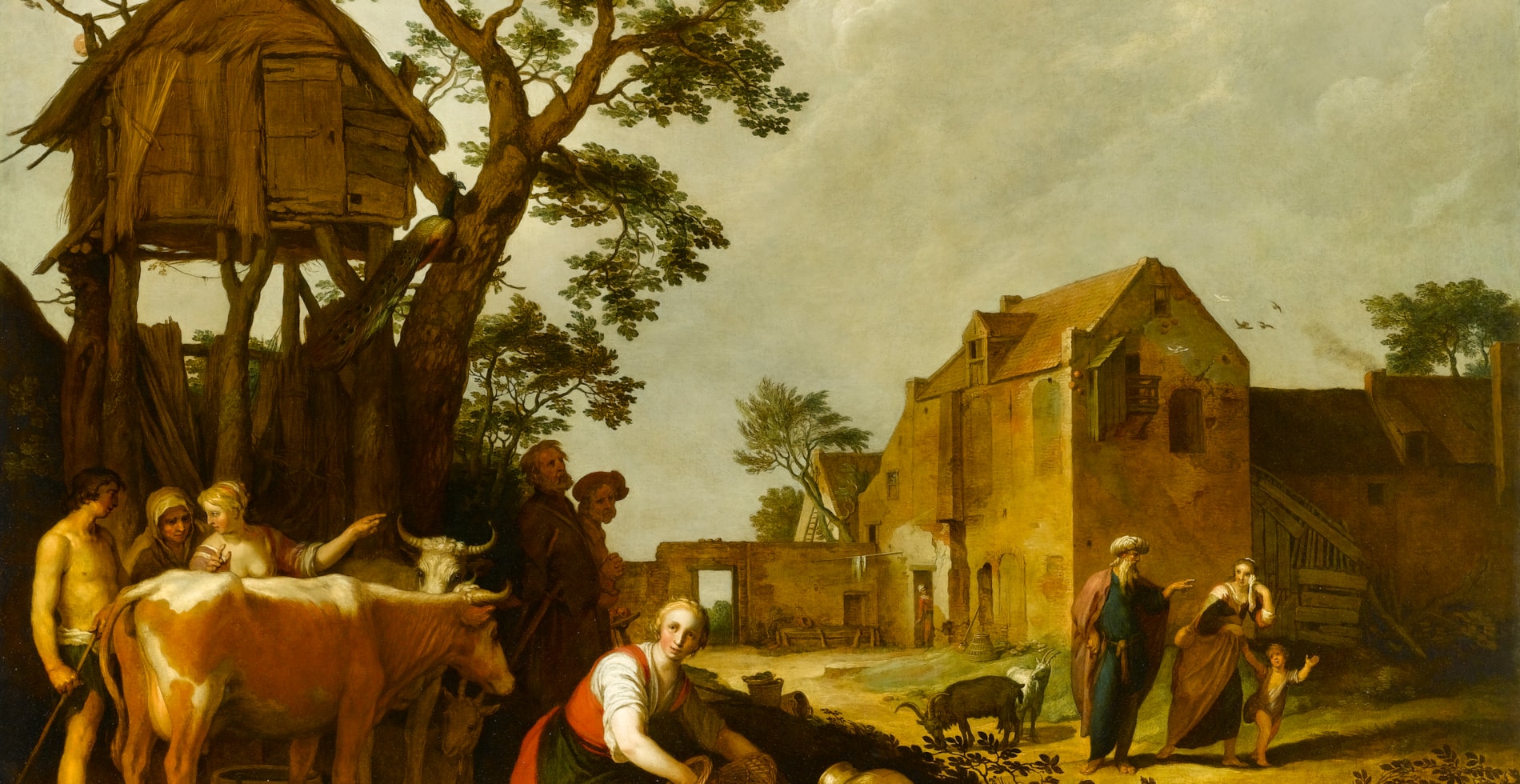
 contact
contact contact
contact +44 20 7313 8040
+44 20 7313 8040